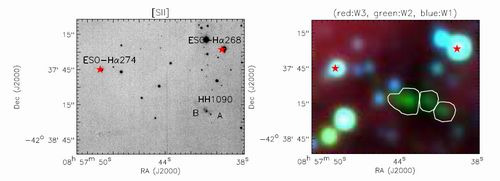Through collaboration with the Max Planck Institute for Astronomy (MPIA) in Heidelberg, a research team in the Purple Mountain Observatory obtained the detailed optical view of the Vela C molecular cloud. They have discovered 18 new Herbig-Haro objects (HHs) and 11 new extended green objects (EGOs) by analyzing their optical images and archival infrared images. The Vela C molecular cloud, as one of the nearest massive star forming regions, is located at a distance of about 2300 light years away from Earth. The new outflows discovered in Vela C confirm this region with active star formation.
According to the low mass star formation theory, stars are born in the molecular clouds. A giant molecular cloud fragments into could cores due to gravity, turbulence, and magnetic fields. Protostars form at the centers of dense cores. A young star accretes surrounding materials through its circumstellar disk and, simultaneously, ejects materials to the interstellar space. Mass outflow is the production of interaction between the ejecta from young stars and the ambient interstellar medium.
Outflows have been detected in different wavelength: the Herbig-Haro objects, as the optical manifestation of mass outflow, trace the material ejected by stars or the shocked surrounding medium while the extended green objects, as the mid-infrared outflows, trace the entrained surrounding medium with lower temperature and density.
Using the WFI instrument at the Max Planck Gesellschaft (MPG) 2.2m telescope of the European Southern Observatory (ESO) in Chile, the research team obtained a clear view of HHs in the Vela C molecular cloud and finally identified 18 new HHs. They also analyzed the archival infrared images from the Wide-field Infrared Survey Explorer (WISE, details can be found in its official website http://wise.ssl.berkeley.edu) and discovered 11 new EGOs. The MPG telescope is built by Zeiss company and maintained by ESO. Through collaboration with MPIA, the scientists in PMO obtained the observing time of MPG telescope.
The Vela C molecular cloud still stays at a very early stage of star formation. Most of young stars in Vela C are embedded in large amounts of gas and dust. Thus it’s hard to detect the young stars directly. However, the outflows from the young stars can pierce the thick cloud and be exposed to the astronomers. The investigation of outflows offers the information of star formation in the Vela C molecular cloud. The discovery of new outflows suggests that the Vela C molecular cloud is an active star forming region. The research team also investigates the possible driving sources of outflows and found 10 young stars with outflows.

By with for ZHANG Miaomiao
An example of outflow discovered in the Vela C molecular cloud. The left panel shows the [SII] narrow-band image of HH 1090. The right panel shows the false-color image of mid-infrared counterpart of HH 1090. This color image is constructed with three WISE images at different wavelength and the EGO exhibits as green color.
The original paper is published in Astronomical Journal: “Herbig-Haro objects and mid-infrared outflows in the Vela C molecular cloud”
(http://adsabs.harvard.edu/abs/2014AJ....148...26Z).




